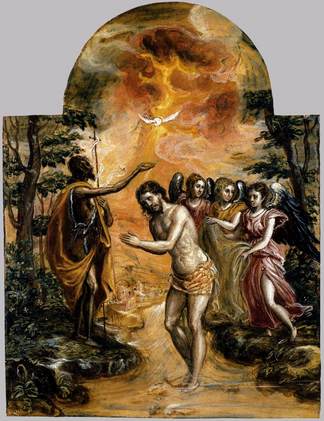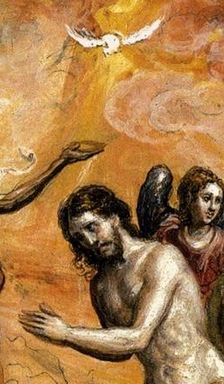Numquam sine aqua Christus

El Greco’s painting of the Baptism of the Lord has, at least to my eyes, a Chagall-like quality. Whereas one would expect a predominance of blues and greens, suggestive of water and vegetation, El Greco uses a palette in various tones of gold, yellow, and brown. Is it dawn or is it dusk? Is it the beginning of the new dispensation, or the end of the old?
Saint John the Baptist seems to be gazing into the heavens. He sees the heavens opening and the Holy Spirit descending. The light from the Holy Spirit seems to be falling directly into the shell he is using to pour the water of baptism over Jesus’ head. Instead of dipping the shell into the river, El Greco shows the Baptist lifting up the shell to receive in its hollow, the gift of the Holy Spirit, the Anointing from above.
The Invitatory
This morning’s Office of Vigils began with a glorious Invitatory Antiphon in the soaring seventh mode. The summit of the melody stretches with a glorious quilisma over the word, Pater. The presence of the Father is all-pervasive in today’s Office.
Christum, Filium dilectum, in quo Pater sibi complacuit,
venite, adoremus.
Christ, the beloved Son, in whom the Father takes delight,
come, let us adore.
The Great Responsory
The First Nocturn’s responsory after the First Lesson is grandiose. It is the same Great Responsory in the third mode given for First Vespers in the Antiphonale Monasticum (p. 112) to open the celebration of the whole feast:
Hodie in Jordane baptizato Domino,
aperti sunt caeli
et sicut columba super eum Spiritus mansit,
et vox Patris intonuit:
* Hic est Filius meus dilectus, in quo mihi complacui.
V. Caeli aperti sunt super eum,
et vox Patris audita est.
* Hic est Filius meus dilectus, in quo mihi complacui.
Today, the Lord is baptized in the Jordan,
the heavens are opened,
the Spirit, in the form of a dove, rests upon Him,
and the Father’s voice resounds:
* This is my beloved Son, in whom my love delights.
V. The heavens opened above Him, and the Father’s voice was heard:
* This is my beloved Son, in whom my love delights.

The repetition of the response, “This is my beloved Son, in whom my love delights,” makes the whole piece a contemplation of the Trinity. One “hears” the love of the Father for the Son in every note of the melismas that adorn the key words: Hic, dilectus, and complacui.
The Mystery of Water
The Reading of the Second Nocturn was taken from Tertullian’s Treatise on Baptism. The fourth lesson is a lyrical tribute to the role of water in the whole economy of salvation. It evokes certain liturgical texts, notably the solemn blessing of water in the night of Pascha. Here is my translation:
What favour water has with God and with His Christ!
Thus is the meaning of baptism confirmed.
Numquam sine aqua Christus!
Never does Christ appear without water!
Christ Himself is immersed in water.
Invited to the wedding feast, it is water that inaugurates the first-fruits of His power.
When He preaches, it is to invite the thirsty to His everlasting water.
When He teaches of sacrificial love (agapé), He recognizes the cup of water offered to one’s neighbor as a work of love.
He rests beside a well of water.
He walks upon the waters, freely crossing over its waves.
He serves His disciples with water, by washing their feet.
These signs of baptism extend even to His Passion.
When He is condemned to the death of the cross, water appears:
it is for the hands of Pilate.
When He is pierced by the soldier’s lance, water gushes from His side.
